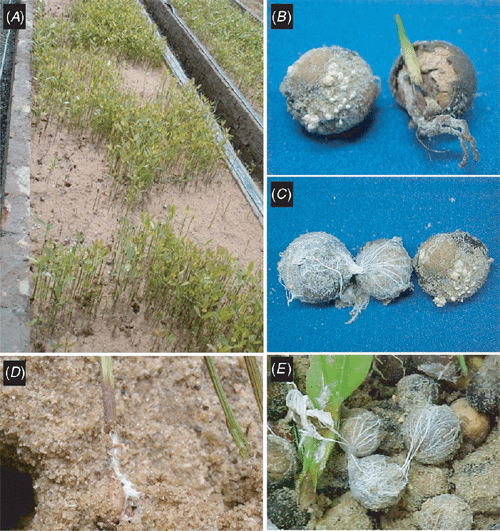First report of Sclerotium rolfsii on Calophyllum brasiliensis in Brazil
C. T. Ohto A , D. D. Rosa A B , M. A. Basseto A , N. L. de Souza A and E. L. Furtado AA São Paulo State University, UNESP, College of Agronomic Science, FCA, Department of Plant Production, Plant Health Protection Sector, PO Box BCG, Botucatu, SP AHFA0-C0G, Brazil.
B Corresponding author. Email: ddrosa@fca.unesp.br
Australasian Plant Disease Notes 2(1) 105-106 https://doi.org/10.1071/DN07043
Submitted: 7 June 2007 Accepted: 25 June 2007 Published: 3 July 2007
Abstract
Damping-off, root rot, brownish spots and necrotic lesions were observed in Guanandi (Calophyllum brasiliensis) seedlings in São Paulo State, Brazil. Sclerotium rolfsii was identified as the causal agent. This is the first record of S. rolfsii on C. brasiliensis in Brazil.
Calophyllum brasiliensis, popularly known as Guanandi or Jacareúba, is an arboreal species that belongs to the family Clusiaceae and typically occurs in riparian forests from the north of the State of Santa Catarina to the Amazon region. It may reach over 40 m in height with a trunk dimeter of more than 1 m, and it produces timber with excellent workability. It is frequently used in civil construction as flooring and roofing timbers, and is also used as a medicinal plant (leaves and bark) (Toniato et al. 1998).
The production of Guanandi seedlings begins in a sand seedbed. After seed germination, the seedlings are transferred to plastic bags containing soil and organic fertilisers. In January 2007, symptoms of damping-off, root rot, brownish spots, and necrotic lesions were observed in the root collar of seedlings in Guanandi seedbeds in the farm production at Garça city (22°12′39′S; 49°39′21′E), state of São Paulo, in Brazil (Fig. 1). Whitish mycelial growth and small whitish sclerotia (120–270 µm in diameter) that later became light brown were associated with the roots of the seedlings (Fig. 1).

|
The diseased material was received and isolated at the Plant Pathology Clinic of the Plant Production Department, Plant Health Protection Sector of the College of Agronomic Sciences, FCA/UNESP, in Botucatu, for analysis. In order to isolate the material, plant fragments were disinfested in alcohol for 30 s and then washed in sodium hypochlorite (2%) for 30 s and washed in autoclaved distilled water. The fragments were then plated on potato dextrose agar (PDA) culture medium and incubated at 22°C for 48 h. After that period, growth of an abundant whitish mycelium was observed, with clamp connections in each septum of the mycelium, in addition to aerial mycelium with a great number of whitish, spherical structures, the sclerotia. New seeds and plantlets were inoculated with sclerotia and incubated in a humid chamber at 24°C for 48 h. After this period, the inoculated and non-inoculated plants were then removed from the humid chamber and the plants were then maintained in a greenhouse where temperatures ranged between 25 and 28°C. Six to seven days after inoculation, the presence of the same symptoms previously seen was observed. The fungus was reisolated from the tissues. Based on morphological and cultural characteristics, the causal agent was identified as Sclerotium rolfsii (Punja and Rahe 1992). Cultures were deposited at the mycology bank in FCA/UNESP.
Sclerotium rolfsii has a wide host range, but is more commonly observed attacking ornamental plants (Punja 1985). It can attack different parts of the plant, but is more frequently found on stems and leaves close to the soil line (Chase 1997). This is the first report of S. rolfsii causing damping-off and root rot in C.brasiliensis in Brazil and anywhere in the world.
Punja ZK
(1985) The biology, ecology and control of Sclerotium rolfsii. Annual Review of Phytopathology 23, 97–127.

Toniato MTZ,
Leitão-Filho HF, Rodrigues RR
(1998) Fitossociologia de um remanescente de Floresta higrófila (Mata de brejo) em Campinas, SP. Revista Brasileira de Botânica 21, 197–210.
| Crossref |



